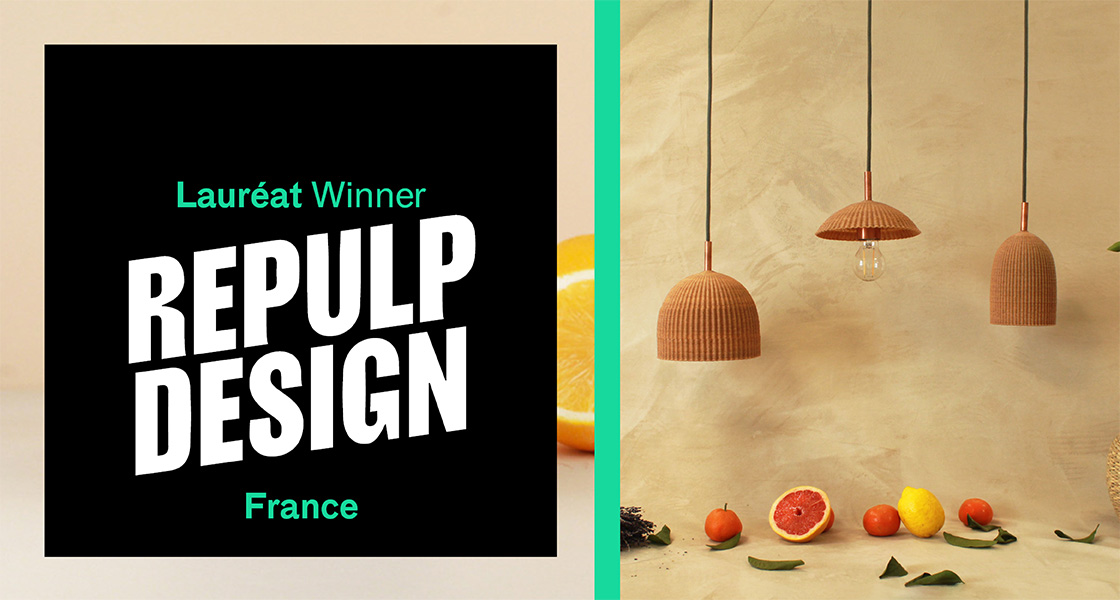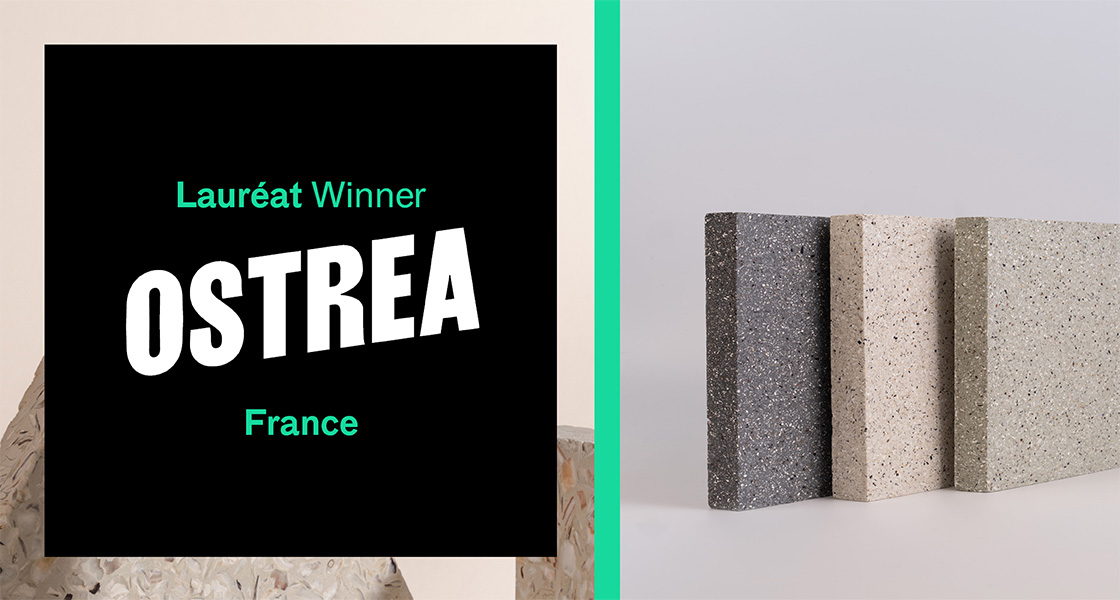Maison&Objet Future On Stage : AND THE BRAND NEW BRANDS ARE…
Published on 7 September 2023

The third edition of Future On Stage recognizes Repulp Design, Komut, and Ostrea. They all take a future-focused approach toward guilt-free production solutions, for products that are reassuring. How will these three eco-design-led firms present their innovations at the Maison&Objet Paris fair from September 7-11, 2023? Here are a few answers from Victoria Lièvre, Philippe Tissot, and Camille Callennec, entrepreneurs oriented toward the absolute minimum and toward autonomy, with a certain concept of what is fundamentally beautiful.

REPULP DESIGN
What is it?: Biodegradable design made from citrus peels.
Made in : Marseille
The story behind the brand: Victoria Lièvre and Luc Fischer, her partner, truly complement each other. She is a graduate in object design, and he went to business school. Before creating Repulp Design, Victoria worked in a juice bar and was amazed at the number of orange peels that were thrown away each day. This pair decided to make this food waste into objects and launched a crowdfunding venture that proved to be as positive as their partnership with a fruit-juice company from Southeastern France. The peel, pulp, and seeds are dried, made into powder, and heated until they can be shaped into cute little coffee cups. Simple, solid, and biodegradable, they foreshadowed a small revolution in the world of tableware. Currently undergoing certification for dishwasher use, their plates can, at the end of their life cycle, be recycled or composted.
And since the manufacturing of this little mug creates scraps, our “repulpers” recover these to make 3D-printing filament. This use of their own waste allows them to develop a range of “Citrus Paradisi” light fixtures, whose shell-like traits remind us of the little coves of Southern France and emit a slightly sugary aroma reminiscent of the Mediterranean.
The innovative idea: Bio-based, rugged, and recyclable, this material made from citrus peel is part of a virtuous cycle that offers a real alternative to plastic.
The flagship product:The 250 ml “Repulp” coffee cup.
The buzz shot: “Being highlighted on the Made in Marseille website generated a record number of comments on the platform and offered us visibility on other media.”
How is REPULP DESIGN revolutionary?
Victoria Lièvre: To my knowledge, no other companies in France have truly examined citrus waste! And it can’t be composted due to its high PH level. This represents 40,000 tons of potential raw material, since oranges are the third most-consumed fruit in France.
What’s next?
VL: We’re looking ahead to accent furniture. Our raw material seems like it would be perfect for shop decor, for example. We’ve had many requests for worktops and closet doors. We’re developing the process so that this can be factory-made.

KOMUT
What is it?: One-piece, single-material furniture that’s recycled and recyclable.
Made in : Pantin
The story behind the brand: Komut for “commuter”. An instant effect was the thing for Philippe Tissot, who didn’t want to wait for the ecological transition over thirty years to shift into a decarbonized world. By producing furniture that has a positive impact, he makes lifestyle products that are supremely sustainable right now. When he used to work on architectural projects in concrete, he burned or buried hundreds of kilos of silicone or polyurethane molds. And so, he looked for a way to make recyclable dies from botanical sources, but the concrete market, which was weighed down with tradition, didn’t follow his initiative quickly enough for his taste. Then came the idea of making the mold a design object in itself. He met a designer originally from Taiwan who works for major fashion brands. YuTyng Chiu also saw herself working on a sustainable project. She had never designed a piece of furniture but knew how to convey emotion through shape. She envisioned collections of coffee tables and seating: “Kilometers”, with its sinuous curves, “Aller-retour”, with its pleated look, and “A4”, with zero straight lines or sharp angles. In this new world, color gradients are accidental, post-processing doesn’t exist, production is on-demand, and everything is remade into furniture. There’s a reason why the latest collection reflects light and is called “Paradise”.
The innovative idea: Carbon neutrality is reached using hungry robots who feed on scraps, using a carbon-neutral production method.
The flagship product: The “0.9 km” lounge chair, which, as its name suggests, is printed using 900 meters of filament.
The buzz shot: An exhibition that lasted over six months within the production facility of the Saguez & Partners architectural firm in March 2022, in Saint-Ouen.
How is KOMUT revolutionary?
Philippe Tissot: Furniture is one of the biggest sources of greenhouse gases. Using our digital craft technique, we design a zero-waste single material that’s carbon-neutral and circular. Our ergonomically designed creations offer a thickness that’s five times greater than normal, offering endless durability and sustainability.
AG: “Next to Orri's geodesic shapes, we will unveil our new protective chair: “Wrap”. It is made up of tubular steel structures, and its textile maintains its curves, cylindrical this time, in different positions”.
What’s next?
PT: We’re going to keep building bridges with other processors such as Pavé®. This helps create a real industry. Previously, recycled aspects were hidden, whether they were found in car bumpers or dashboards. By refining them, we can have beautiful objects of value in our environment.

OSTREA
What is it?: A material that is made up of 65% oysters, mussels, and scallops.
Made in: Rennes
The story behind the brand: Tanguy Blévin has a big brother who’s an oyster farmer in Riec-sur-Belon (in the Finistère Sud region). He became aware of the amount of waste generated by shellfish farming: 250,000 tons of shells are taken to engineered landfill sites each year. This has a considerable environmental and economic cost for local areas. With his childhood friends Camille Callennec and Théo Joy, and Maxime Roux, a Parisian who’s passionate about the sea, he thought about how to reuse this mineral in an ultra-low-carbon, recyclable material. In 2022, after two years of research and development, this group of friends created the Ostrea firm and presented their product at Paris Design Week. And it was a bountiful catch. Tanguy decided to specialize in purchasing and logistics, Maxime in digital marketing, Théo Joy managed the technical and digital aspects, since he is in charge of the FabLab at the École européenne supérieure d’art de Bretagne (Brittany European School of Art) in Rennes, and Camille became the big organizer of it all.
Fireproof and scratch-, water-, and stain-resistant, this material made from shell flakes, the result of all their efforts, is similar to marble. It can be shaped into food trays, stools, and tiles. As visitors, this team is very familiar with Maison&Objet Paris. Now, they’ve crossed to the other side of the mirror…a mirror with a scallop-shell frame.
The innovative idea: Reducing the dumping in landfills of hundreds of thousands of tons of shells, by making them into low-carbon wall and floor coverings and furniture.
The flagship product: Bistro and conference tables.
The buzz shot: The immense traction they got when presenting their prototypes and samples at Paris Design Week last September.
How is OSTREA revolutionary?
Camille Callennec: It’s the first-ever mineral, bio-sourced, renewable material. We’re not drawing from fossil-fuel resources. We’ve worked quite a bit on its composition (with no resin) and its production process (with no kiln used), which makes this one of the lowest-carbon recycled materials on the market.
What’s next?
CC: Making kitchen countertops, washbasin countertops for bathrooms, and counters for indoor and outdoor use. We’ve just confirmed a series of furnishings with fittings specialist Kipli. And we’re going to be developing cast flooring.